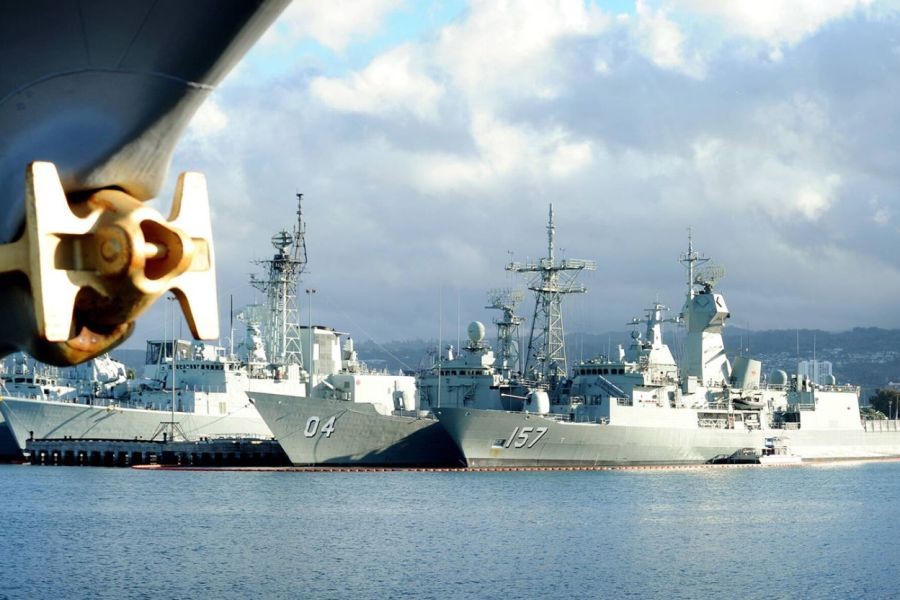The Indo-Pacific region, a vast maritime expanse, represents a crucial artery for global trade, with Australia positioned as a pivotal player in its protection. As geopolitical tensions rise and the strategic importance of these waters intensifies, the role of the Australian Navy in safeguarding trade routes becomes ever more critical. This article delves into the strategies deployed by the Australian Navy, highlighting their impact on national security and economic stability while examining the broader implications for Australia's industries and policies.
The Strategic Importance of the Indo-Pacific
The Indo-Pacific region is not only a hub of economic activity but also a focal point for complex geopolitical dynamics. Approximately 60% of global maritime trade passes through these waters, underscoring its significance. For Australia, a nation heavily reliant on trade, maintaining secure and free-flowing trade routes is paramount. The Australian Bureau of Statistics (ABS) reveals that exports and imports account for around 45% of Australia's GDP, emphasizing the critical role of uninterrupted trade in the nation's economy.
Australia's Economic Stake
Australia's economy is intricately linked to the Indo-Pacific. The Reserve Bank of Australia (RBA) highlights that the region's stability directly influences Australia's economic well-being. For instance, disruptions in these trade routes could lead to substantial economic losses, affecting industries ranging from mining to agriculture. The Australian Competition & Consumer Commission (ACCC) notes that such disruptions could further lead to increased costs for consumers and businesses alike.
Protective Measures by the Australian Navy
Advanced Surveillance and Technology
The Australian Navy employs cutting-edge technology to monitor trade routes, ensuring the detection and deterrence of potential threats. Utilizing AI and machine learning, the Navy enhances its maritime surveillance capabilities. These technologies enable real-time data analysis, providing actionable insights to preemptively address risks.
Collaborative Efforts and Alliances
Collaboration with regional allies is a cornerstone of Australia's naval strategy. The nation actively participates in joint exercises and information sharing with allies such as the United States, Japan, and India. These partnerships bolster regional security, promoting a unified approach to maritime challenges.
Case Study: Operation Gateway
Operation Gateway exemplifies the Australian Navy's commitment to regional security. This ongoing operation focuses on the surveillance of the northern Indian Ocean and the South China Sea. By deploying advanced maritime patrol aircraft, the operation ensures a persistent presence, deterring potential threats and fostering stability.
- Problem: Increased piracy and potential military conflicts threatened trade security.
- Action: Deploy advanced surveillance aircraft and collaborate with regional allies.
- Result: Enhanced threat detection and increased regional stability.
- Takeaway: Collaborative efforts and technological advancements are vital for maritime security.
Challenges and Considerations
Geopolitical Tensions
Geopolitical tensions, particularly involving major powers like China, pose a challenge to maintaining secure trade routes. The Australian government must navigate these complexities, balancing national interests with regional stability.
Environmental and Ethical Concerns
The environmental impact of naval operations is a growing concern. The Australian Navy is committed to sustainable practices, minimizing ecological footprints through the adoption of cleaner technologies.
Future Trends and Innovations
AI and Autonomous Systems
The future of maritime security lies in AI and autonomous systems. These technologies promise enhanced efficiency and effectiveness in monitoring and protecting trade routes. By 2028, experts predict that 70% of surveillance operations will be AI-driven, revolutionizing naval operations.
Policy and Regulatory Developments
Upcoming policy developments, such as enhanced maritime security regulations, will shape the future landscape. The Australian government is expected to introduce comprehensive measures to ensure the protection of trade routes, balancing security with economic interests.
Common Myths and Misconceptions
- Myth: The Indo-Pacific is primarily a military arena.
- Reality: While military presence is significant, economic interests and trade are the primary focus, driving collaborative efforts for stability.
- Myth: All naval operations are environmentally harmful.
- Reality: The Australian Navy is actively adopting sustainable practices, reducing its environmental impact through cleaner technologies.
Final Takeaways
- Fact: The Indo-Pacific is crucial for global trade, with 60% of maritime trade passing through its waters.
- Strategy: Collaborative efforts and technological advancements are key to maintaining secure trade routes.
- Mistake to Avoid: Underestimating the impact of geopolitical tensions on trade security.
- Pro Tip: Investing in AI and autonomous systems can significantly enhance maritime surveillance capabilities.
Conclusion
As the Indo-Pacific continues to grow in strategic importance, the Australian Navy's role in protecting trade routes is paramount. By leveraging advanced technologies and fostering regional alliances, Australia ensures the stability and security of these vital maritime corridors. Looking ahead, embracing innovations and sustainable practices will be crucial in navigating the challenges and opportunities that lie ahead. What strategies do you think are most effective in safeguarding trade routes? Join the discussion and share your insights!
People Also Ask (FAQ)
- How does the Australian Navy protect trade routes? The Australian Navy uses advanced technology, collaborates with regional allies, and conducts surveillance operations to safeguard trade routes.
- Why is the Indo-Pacific important for Australia? The Indo-Pacific is vital for Australia's economy, with a significant portion of trade passing through these waters, directly impacting GDP and industries.
- What future trends will impact maritime security? AI, autonomous systems, and policy developments are set to revolutionize maritime security, enhancing efficiency and effectiveness.
Related Search Queries
- Australian Navy Indo-Pacific strategy
- Indo-Pacific trade routes importance
- AI in maritime security
- Geopolitical tensions in the Indo-Pacific
- Australia's economic reliance on trade
- Sustainable naval operations
- Future of maritime security technologies
- Operation Gateway and regional stability
- Australian Navy and regional alliances
- Indo-Pacific geopolitical challenges































ChristineF
7 months ago